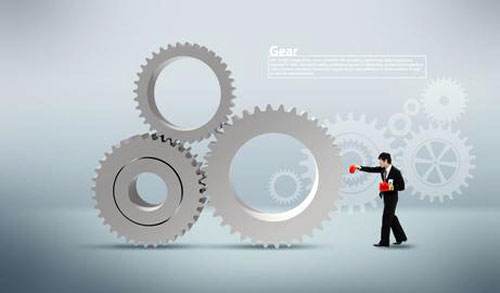
当前课程知识点:History of Western Civilization 全英文西方文明史 > Chapter 5 Middle Ages > 5.1 Early Middle Ages > 5.1.1 Text
返回《History of Western Civilization 全英文西方文明史》慕课在线视频课程列表
Chapter Five Middle Ages
Every time I start this chapter. I feel a little bit sad, because we have to say goodbye to the ancient Greece and ancient Roma. They are glorified times
5.1. Early Middle Ages: 5th to the 10th century
1. Three periods of the Western world
The history of the western world has been traditionally divided into three periods. The first one is classical antiquity, also called the classical era, classical period or classical age. It is the period of between the 8th century BC and the 5th century AD centered on the Mediterranean Sea, including ancient Greece and ancient Rome, known as the Greco-Roman world.
The second one is the Middle Ages also called Medieval Period or Dark Ages, lasted from the 5th century Fall of Rome to the 15th century. The third one is the Modern history from the early 16th century to today. The Modern history can be further divided into three periods: The early modern period began in the early 16th century including the Renaissance, the Age of Discovery, and the Protestant Reformation. The late modern period began in the mid-18th century, including the French Revolution, the American Revolution, the Industrial Revolution, the Great Divergence, the Russian Revolution and the two World Wars. Contemporary history is the period after the end of the second Word War in 1945 to present time.
2.The Early Middle Ages lasted from the 5th century followed the decline of the Western Roman Empire to the 10th century, marked the start of the Middle Ages. The Early Middle Ages overlap with Late Antiquity. "Late Antiquity" is the term to describe the time of transition from classical antiquity to the Middle Ages. This period saw the migrations of Germanic tribes and the Huns into the Roman world, the making of the barbarian kingdoms in the west Europe, the survival of the Byzantine Empire and the Rise of Islam.
3. Italy
Odoacer, first King of Italy.
In 476, Odoacer deposed the western emperor Romulus, and Odoacer became the first King of Italy. Odoacer was of barbarian descent from an East Germanic tribe. This was the end of the Western Roman Empire and the beginning of the Middle Ages. Odoacer represented himself as the client of the Eastern Roman Empire, his kingdom of Italy was a vassal state of the Eastern Roman Empire which lasted from 476 to 493
The Ostrogothic Kingdom
In 493 Odoacer was killed by Theoderic the Great, a leader of Ostrogoths, an eastern branch of Goths. He established the Ostrogothic Kingdom, also called the Kingdom of Italy which lasted from 493 to 553. Theodoric wanted to be leader of both Goths and Romans, thus he called himself "King of the Goths and Romans". This Ostrogothic Kingdom was conquered by the Eastern Roman emperor Justinian. But in 568 the Romans was unable to resist the invasion of another Germanic people the Lombards.
The Lombard Kingdom ruled most of the Italian Peninsula from 568 to 774. In 774, this Kingdom was conquered by the Frankish King Charlemagne and became part of his Empire.
4. The Papal States. Pope Saint Gregory I was Pope of the Catholic Church from 590 to 604. He is famous for sending the first recorded large-scale mission from Rome to convert the then-pagan Anglo-Saxons in England to Christianity. He is also famous for defending the city of Rome from the invasion of Lombards. Gregory laid the foundations of the medieval papacy. After Charlemagne conquered the Lombard Kingdom, Rome and its surrounding area still remained as a sovereign State called the Papal States officially the State of the Church until 1870.
5. Spain.
Today’s Iberian Peninsula also known as Iberia is divided between Spain and Portugal. Around 200 BC, it was conquered by Romans and became the Roman province of Hispania. In 410 Visigoths, the western branch of the Goths captured Rome and sacked it for three days. Finally they left and moved to southern Gaul and Spain and established a Visigothic kingdom there which lasted from 5th to 7th century. In 711 a force of invading North African Moors conquered the Visigoths. Moors are Muslim people of mixed Berbers and Arab ancestry. Later it became part of the Muslim Umayyad Caliphate. Berbers are an ethnic group indigenous to North Africa.
6. Britain
Britain was conquered by Romans in AD 43 and it became the Roman province of Britannia until the early 5th century. Then Anglo-Saxons, including Angles, Saxon, and other Germanic tribes conquered Britain. They called it England meaning land of Angles. Anglo-Saxons established some small kingdoms but didn’t form a united kingdom until the eleventh century. The central values of Anglo-Saxons were honor and glory. Fighting was an important part of their life. In 565 Pope Gregory sent Augustine as missionary to England to convert Anglo-Saxons. Pope named Augustine archbishop of Canterbury. He laid the foundations for a hierarchical, bishop-centered church based on the Roman model. The Archbishop of Canterbury is the most senior cleric of The Church of England. In 865 Vikings from Denmark invaded England, they conquered all the small kingdoms but one, Wessex. The king of Wessex Alfred was a great leader, he defeated and stopped the Danes. The Danes were forced to accept Christian baptism and withdraw from Mercia. By the time of the death of Alfred in 899, southern England was united by Wessex. From this map we can see Wessex and the region controlled by Danes known as the Danelaw.
7. Scandinavian Vikings
Norseman means "man from the North", they are group of Germanic people inhabited Scandinavia. They spoke the Old Norse language. Norseman could be any person from Denmark, Norway and Sweden. The Vikings were Northmen who sailed from Scandinavia and raided other part of Europe from the 8th to the 11th centuries. Besides raiding they also traded. From this map we can see the travels of the Vikings. Swedes to the east, trading with Slavic world and Byzantine. Norwegians to Ireland and Scotland and Greenland. And Danes focused on England and Frankish empire. Swedish merchant Vikings, known as Rus traveled down along the Volga and Dnepr rivers to the Black sea in search of furs and slaves. They built settlements in Novgorod and Kiev. Today the peoples of Belarus, Russia and Ukraine all claim Rus as their ancestors, Belarus and Russia all derived from it.
8. Frankish kingdom Merovingian dynasty
Frankish Empire or the Kingdom of the Franks was the largest Barbarian kingdom in Western Europe during the Early Middle Ages which lasted from 481 to 843. It is the director ancestor of both modern France and Germany. This is the territory of the kingdom.
9. The Frankish Kingdom was ruled by the Salian Franks, a subgroup of the Franks, Franks is a collection of western Germanic peoples. Frankish Kingdom has two dynasties. The first one is the Merovingian dynasty that ruled for nearly 300 years from 450 to 751. The Frankish kings of this dynasty called themselves Merovingians "descendants of Merovech", they believed Merovech was founder of the dynasty. But historians believed Merovech was a semi-legendary figure for the lack of written evidence. The real founder was the grandson of Merovech, Clovis, He was the leader of the Salian franks and a commander of the Roman barbarian army. In 486 he killed the last Roman commander in the West and became the first Frankish king, the first king of what would become the future France. Clovis eventually converted to Catholicism on Christmas Day 508. This conversion paved the way for the assimilation of Franks and Romans into a new society. This cultural fusion or blending of the Germanic people, Romans, and Christianity became the model for the future social and political development of Europe. With Clovis's conversion to Catholicism, the Frankish monarchy, elective and secular until then, became hereditary and of divine right.
10. When Clovis died in 551, his kingdom was divided by his four sons for the next 200 years until the end of the Merovingian dynasty in 751.
Now let’s look at the Key words
Middle Ages, Anglo-Saxons, Vikings, Frankish kingdom, Clovis.
This is the end of the first part of 5th Chapter, Early Middle Ages
返回《History of Western Civilization 全英文西方文明史》慕课在线视频列表
-1.0 Introduction
--1.0.3 Exercises
-1.1 Greek Bronze Age and Dark Age
--1.1.3 Exercises
-1.2 Greek Gods
--1.2.3 Exercises
-1.3 Archaic Greece
--1.3.3 Exercises
-1.4 Athens and the Persian Wars
--1.4.3 Exercises
-1.5 Discussion
-2.1 War and politics in the fifth century BC
--2.1.3 Exercises
-2.2 Greece in the fourth century BC
--2.2.3 Exercises
-2.3 Classical Greek Philosophy
--2.3.3 Exercises
-2.4 Athenian Drama
--2.4.3 Exercises
-2.5 Alexander the Great and Hellenistic World
--2.5.3 Exercises
-2.6 Discussion
-3.1 Roman Kingdom
--3.1.3 Exercises
-3.2 Early Republic
--3.2.3 Exercises
-3.3 Mid-Republic
--3.3.3 Exercises
-3.4 Late-Republic
--3.4.3 Exercises
-3.5 End of the Republic
--3.5.3 Exercises
-3.6 Discussion
-4.1 Pax Romana 1
--4.1.3 Excecises
-4.2 Pax Romana 2
--4.2.3 Excecises
-4.3 Crisis of the Third Century and Constantine
--4.3.3 Excecises
-4.4 The Victory of Christianity
--4.4.3 Exercises
-4.5 The Fall of the Roman Empire
--4.5.3 Exercises
-4.6 Discussion
-5.1 Early Middle Ages
--5.1.3 Excecises
-5.2 Carolingian Dynasty
--5.2.3 Excecises
-5.3 High Middle Ages
--5.3.3 Excecises
-5.4 Late Middle Ages 1
--5.4.1 Excecises
-5.5 Late Middle Ages 2
--5.5.3 Excecises
-5.6 Discussion
-6.1 The Renaissance
--6.1.3 Exercises
-6.2 Protestant Reformation
--6.2.3 Exercises
-6.3 Italian Wars and Rise of Russia
--6.3.3 Exercises
-6.4 Age of Discovery
--6.4.3 Exercises
-6.5 French War of Religion and Russia’s Time of Trouble
--6.5.3 Exercises
-6.6 Discussion
-7.1 The Thirty Years War
--7.1.3 Exercises
-7.2 English Revolution
--7.2.3 Exercises
-7.3 Three Absolute Monarchs
--7.3.3 Exercises
-7.4 Dutch Golden Age
--7.4.3 Exercises
-7.5 Science and Culture in the 17th Century
--7.5 Text
--7.5.3 Exercises
-7.6 Discussion
-8.1 The United Kingdom
--8.1.3 Exercises
-8.2 The American Revolution
--8.2.3 Exercises
-8.3 The French Revolution
--8.3.3 Exercises
-8.4 Age of Enlightenment
--8.4.3 Exercises
-8.5 West after the 18th century
--8.5.3 Exercises
-8.6 Discussion

